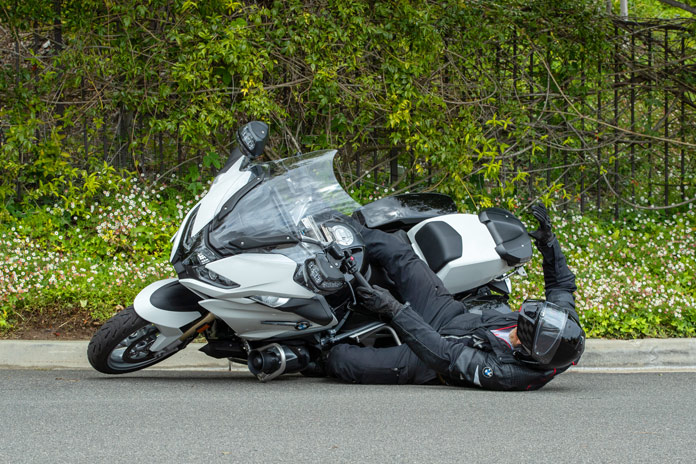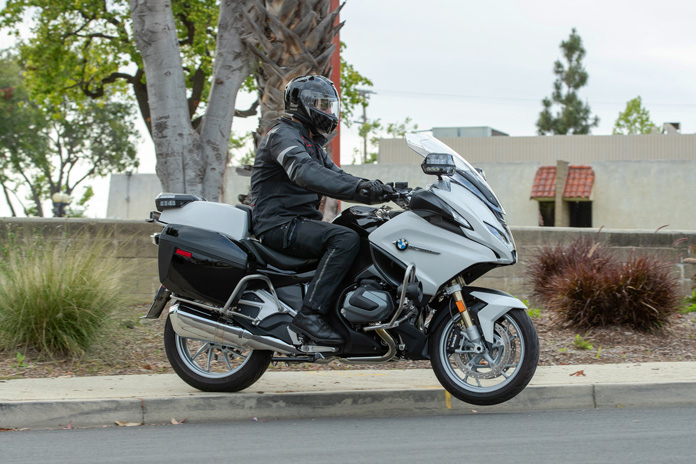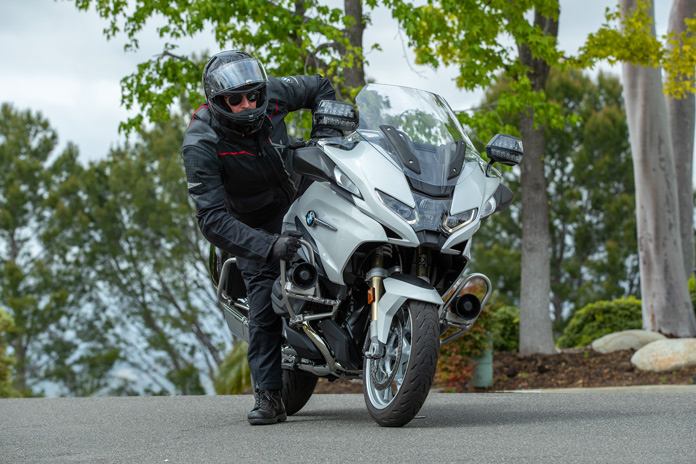
In my career, my police motor slammed the pavement exactly five times when deploying the kickstand and dismounting the bike. And yes, it was on par with that dream we’ve all had where you show up at school with no pants and all the kids laugh at you. Exceedingly embarrassing for sure, but thankfully I’m still alive and riding because every single time I dropped my bike, I was following the Golden Rule: “Always and forever mount and dismount your motor from the high side.”
That’s right, folks. It turns out there’s a correct side of the motorcycle to get on and off from, and it isn’t the side most of you use. Sounds ridiculous, right?
Now, I know you’ve successfully accomplished the task of resting your motorcycle on its kickstand thousands of times. Heck, you’re almost psychic when it comes to surface appraisal and road camber when you boot that stand out. In fact, you’re probably cursing me in your head, arguing that which side you mount or dismount from ultimately depends on where you park your bike or which hand is holding your Milk Duds. But in motor school, I learned the best way to get on and off a motorcycle: from the “high side.”
Perhaps it’s obvious, but in case I lost you, allow me to explain. For the most part, kickstands are deployed from the left side of the motorcycle. If you put your motorcycle on its kickstand, the bike will settle, or lean, to the left. Therefore, if you were to stand directly behind the bike, the “high” side is the right side of the bike, or the side where your throttle and front brake lever are located. Since the bike is leaned over on the stand, the seat is higher on the right side. Make sense?
Keep in mind that all vehicles in the United States travel on the right side of the road, with opposing traffic on the left. Now, let’s imagine you are riding along and need to get that super tight blue sweatshirt that you love to show off out of your saddlebag. You pull to the side of the road, kick your stand down, and start getting off the bike. But on this particularly cruel day, your bike begins to roll off its kickstand, resulting in the bike falling to the left – or “low” side – and toward traffic.
Adding chaos to the scenario, it turns out your right leg is the one with a wonky ACL and two meniscus surgeries, so you decided to plant your left foot on the ground and started your dismount on the left (low) side of your bike as it began to fall. Regrettably, your bike starts falling directly onto your one good leg, potentially knocking you into oncoming traffic as it wraps you up and takes you down with it. Not great.
Now let’s put on our mirrored rainbow glasses and imagine you dismounted from the “high” side as your motorcycle started to fall off the kickstand. Not only will you look fabulous, but your right leg will remain planted so your left leg can gracefully swing over the seat like a gazelle’s, safely clearing you from the bike as it ponders what parts and pieces to destroy as it slams to the pavement. Embarrassing and costly? Absolutely, but pretty low risk to you physically.
The good news is this technique pays dividends not just when parked on the road but also in parking lots, your driveway, or anywhere else you throw that kickstand down. I can’t promise that your buddies won’t find some other reason to make fun of you, but like I’ve said a thousand times, you bring that crap on yourself.
So, from now on, follow my little parking ritual: Shut off the bike, put it in 1st gear, deploy the kickstand, turn the handlebar full‑lock left, gently ease the bike over onto the kickstand, and step off the high side of the bike. If you need a little assistance with your dismount, grab the front brake and use the handlebar for leverage. And while the process is simple enough, give it a few dry runs in the garage first. Practice makes perfect, though I can’t promise you won’t get weird looks from your friends.
Bonus Motor School Tips
As the late, great Billy Mays used to say, “But wait, there’s more!” Here are a couple more tips to help you out there on the street.
Curb appeal: If you find yourself in a situation where you need to ride your big heavy bike off a curb, accelerate off rather than tiptoe and duck walk the front wheel off the drop where the lower fairing, oil pan, or pipes could get smashed. I’m not suggesting you channel your inner Daniel J. Canary, the man who invented the wheelie, but ride off like you would accelerate from a typical stop: in a straight line with smooth, assertive throttle (as shown in the photo below).
And yes, I know firsthand what a great tip this is because I once watched a fellow motor officer gingerly roll his new BMW R 1250 RT‑P off a tall curb at a DUI checkpoint. After hearing a gut‑wrenching pile‑driver concussion, I watched as hot oil spewed out onto the pavement. Oof.

Brake time: If your bike has been sitting unridden for a while, be sure to work your brake levers and pump up the calipers before you take off. When I first heard this suggestion from an old motor cop, I laughed out loud. But then he walked me over to my bike, gently pushed on my front brake calipers with his boot, and asked me to grab the front brake lever. With a cocky gleam in my eye, I pulled the lever, only to have it bottom out at the throttle grip – the brakes didn’t work at all. Turns out the fluid in your brake calipers can be forced back into the master cylinder if bumped or pushed hard enough, causing the brakes to need some pumping up before they work again.
Find Quinn at Police Motor Training. Send feedback to rider@ridermagazine.com.
See all Motor School with Quinn Redeker articles here.










I never had any problems getting in or out of my motorcycles. I have sport, cruise and touring bikes. On my sport and cruise which there is no bags or back trunk I use to do it as everyone would do it normally meaning your right leg over the back seat rotating counter clockwise. On my tourings (GL1200 and Road Glide Ultra) stretching my right leg over the front seat and sliding over to the other side until reaching the pavement. Never had any trouble.
This process is definitely NOT easier from a mounting/dismounting perspective. But it’s a process that answers the most amount of “what if’s” in parking/stopping situations from a safety standpoint. My goal here is to introduce an idea of mounting and dismounting your motorcycle that will keep you safe, not necessarily make things easier on you. Think of it as tough love.
But what if I rip/tear the inseam in my riding pants while stretching over to the right side? Lose some weight, you say. What if I don’t have a third point of contact when swinging the left leg over the highest part of the bike? Stand “up” before swinging left leg over, you say? What if I’m not an LEO on a bike, and I rarely, if ever, need to “park” and get off with traffic? Preventative move, you say.
I say, how about involving some basic common sense. I say consider one’s area: weather conditions, traffic conditions, grade of the road, the angle your particular bike sits at when the stand is down. What works for LEO’s and their brethren does not always translate to everyday riders like myself. I also say to ensure that your bike is in gear, or in my case, that the “park” brake is engaged before dismounting. I also double check that my kickstand is extended fully before dismounting. Only takes 2 seconds to kick it again to ensure full extension, thereby negating the bike “moving forward” on it’s own.
All good point in the article. Well thought out and clearly explained. But there’s always more than one to skin that cat….
Cheers…
Craig – First off, I was a husky young boy and I know firsthand what a bad situation torn pants can put you in…so your first point hits home for sure. And if you have already thought of all the “what if’s” within your process and it covers all the variables and conditions you might face, definitely disregard my advice and continue doing it your way. But when it comes to getting knocked into traffic, it takes exactly one time for that to bite you, and in motorcycle riding I live by the philosophy of “possibility” that something could happen, rather than the “probability” it could due to minimal exposure to certain riding situations. Yes, if you are less flexible, older, shorter, on bigger/taller equipment, geared up in certain configurations, and a million other situations we could debate, this way is more of a hassle. And “probably” your way will continue to work fine for you. That said, this process requires no kickstand double-check, minimal surface appraisal, keeps us unbound from the bike no matter what happens, and provides a repeatable routine in all situations. In other words, it’s muscle memory, set it and forget it. Is it perfect for everybody all the time? Absolutely not.
I can quite believe a motor cop would want to get off on the non traffic side of the bike so we should all get comfortable doing this. But I recall trying to mount my Tiger Explorer from the right. The suspension compressed and I had a tiger coming at me! Perhaps the high side is only for dismounting?
Definitely agree with the Right Side is the Right Side for me. I’ve done it both ways over many years of riding and from my personal experience, mounting / dismounting from the high side (right side) works best and is the safest for me. This is especially true on taller bikes, since I can use the right foot peg as a step and just swing a leg over. I also agree that not everyone feels the same way, but be forewarned, it is safer.
I am actually surprised that no mention was made of the BEST reason for a high side (right side) dismount. IT KEEPS THE RIDER FROM INADVERTANTLY STEPPING INTO TRAFFIC.
Jose- absolutely solid thinking, keeping us away from traffic in the first place is a big benefit of this process. I think I skipped over your point because it’s not so much that we are within a traffic lane upon immediate park/dismount, but rather have the potential for falling into it if the bike tumbles over. But my response to you is probably more so motivated by the fact that I can’t change my story at this point and I’m trying to defend myself for having omitted your good point. If I’m honest I’m a little irritated that you failed to give me a heads up before it went to print.
I would add to your article; put your bike in first gear and kill the engine (switch or handlebar). Then release the clutch and let the bike settle against the motor’s compression. Then deploy the kickstand. My reading of your description wasn’t clear about the desired result, that the bike cannot roll forward while on the sidestand. I always like to feel the bike as immovable prior to the kickstand going down. But then I have a 200k+ R100GS with the spring-loaded sidestand, so have lots of practice worrying about the bike falling over, lol.
At 68, I don’t clamber on and off like I used to, but will give the high-side exit some practice. Would have been easy 30 years ago.
Greg- The best thing about your process is that you have a process, and you clearly did the math over time and integrated it into your routine. That right there is a big win. Well said and well done!
Rider Age, Leg Length and Fitness, along with the size and configuration of the bike, and of course the dismount/remount situation, surface, time of day, weather, etc., are all variables in this process, and one size does definitely not fit all.
#1 is that Police motors are massive to begin with, and these riders are FIT!
Rule 1 for them is to Dismount Away From Traffic, plain and simple.
In my over 50 years of riding, the process has varied accordingly, with all of those factors first mentioned (and I am certain there are more). in my early days, I’d dismount left without deploying any side stand, and pull my BMW R69S right up on its center stand. Rarely used the side stands, as they seemed to be an engineering and fabrication afterthought back then.
As I got older, and less fit, and probably also because I was riding Liter-Plus bikes, my process began to evolve. The side stand’s been deployed more as a “crutch,” both literally and figuratively, against any miscalculation on my part, as normally I’d go directly to the center stand for maximum stability and less of a footprint in my garage.
As usual, YMMV (your mileage may vary), but to insist that “Dismounting on the High Side” is THE WAY, is much too narrow an approach, IMHO. Thanks for bringing this all to the surface. It gives us all a reason to reflect on what we do, and could perhaps do better.
Sam- If my article implied I was planning to write my congressman and put my dismounting process into law, then my apologies. My communicated experiences that result in MY “best practices” should NEVER be interpreted as “insistence” on my part that you follow my program. But rather- look at it, try it on, check yourself out in the mirror and see how you look. I think its safe to say one size does not fit all in life but I believe that’s probably the coolest thing about all this stuff. So for that, I thank you for pushing back a bit.
Excellent suggestion. However, for us who might be, let’s just say, vertically challenged, your article did not say whether you can use the right side foot peg as an anchor while you swing your left leg over the saddle or whether you absolutely have to ground your right foot on the pavement in order for this to be a safe dismount. Please clarify. Thank you in advance. -p
Peter- First off, let me point out that the bulk of top motorcycle racers in the world, regardless of discipline, are smaller in stature. And as a 6’2″ larger framed guy, I’ve spent plenty of years on-track cursing at smaller men for the advantages nature provided them. But I digress. To your question, I DO see plenty of people mounting via first stepping on the outside (right-side) foot peg prior to swinging a leg over. And while I have yet to witness it cause problems either on or off-road, I do think it could be problematic from a “what if” standpoint. Specifically, this technique does two things I worry about- 1) it puts significant stress on the kickstand and whatever surface it’s resting on. That means the stand could bend or break, or could dig a hole into the dirt and make the bike fall over. Understand the key word here, “could.” 2) Because you start the mounting process by stepping onto the outside (right-side) foot peg, your total rider weight is committed to the bike if, for any reason, it starts shifting, falling over, rolling. This scenario is exactly what I want to avoid-I do NOT want to get tangled up with the bike no matter what it does. Until I have FULL control of the bike (seated, feet planted) I don’t want to have to trust that the stand is strong, the ground is solid, the camber is level, the bike isn’t gonna roll, etc. So yes, I want my foot anchored to the ground. But I DO have a solution for you that plenty of vertically challenged motor cops employ: Step your left leg THROUGH the bike at the seat (this is the lowest point), rather than OVER the rear. This is much easier and still keeps you independent of the bike, should things go south. Hopefully that makes sense. Most importantly, the simple fact that you have these ideas in your brain and are doing some mental math on then, regardless of your final process, I consider to be a huge win. And thanks for not shaming me for my beyond-optimal size when it comes to this activity I love.
Getting on your ride on the left side is a difficult habit to break. You can the peg or foot board to mount the bike on the right side. That makes it easier for us height challenged people.
Thanks Quinn. You have given me a lot to think about and, more importantly, even more to practice. I started today. -peter
My wife and I took a Pro Rider class in Pittsburgh. Our instructor was BJ McCullium ( hopefully I spelled that correctly) He mounted the motorcycle in this fashion and gave us the same explanation. Great advice!
I don’t know why you guys won’t listen to one of the most skilled riders on the planet. Alright – for you old guys (like me), try standing on the right footboard/peg and your left leg will go over easy. My hips and knees are very inflexible and mounting from the left is near impossible because I can’t raise my leg high enough, so standing on the right floorboard makes it easy. Make sure your handlebars are full lock left and hold the front brake lever, and keep weight centered over the motorcycle when mounting and dismounting. This definitely works on the heavier cruisers with a lot of weight on the kickstand when parked.